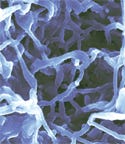Scientists Search under the Sea for Polymer Inspiration
Wireless data collected directly from patients during normal physical activities could enable the development of better knee implants
May 2, 2008
Originally Published MPMN May 2008
NEED TO KNOW
Scientists Search under the Sea for Polymer Inspiration
|
A polymer-based nanocomposite switches from a hard to a soft state upon exposure to water. |
Biomimetics has been a driving force in the recent development of novel new materials with potential medical applications. A slew of scientists cite nature as the source of inspiration for materials modeled after the biology of everything from geckos to mussels. The latest material breakthrough to follow in this fashion hails from a team of researchers at Case Western Reserve University (Cleveland; www.case.edu), who borrowed from the sea cucumber to produce a polymer that is capable of altering its state upon exposure to water.
Building on several team members’ prior work with nanocomposites, the researchers set out to engineer a material modeled after the “smart” skin exhibited by sea cucumbers. Their unique skin can transform from a normally soft, flexible state that helps the creatures navigate obstacles along the ocean floor, to a hard, rigid one that acts as a protective shield in response to the threat of danger.
“Using the skin of sea cucumbers as blueprints, we have developed nanocomposites that can change their mechanical properties on command,” explains Jeffrey Capadona, associate investigator at the Louis Stokes Cleveland Department of Veterans Affairs Medical Center (Cleveland; www.cleveland.va.gov) and one of the researchers. “Our first materials were designed to respond to a chemical compound or stimulus—exposure to water.”
Capadona, along with Case Western graduate student Kadhirivan Shanmuganathan and professors Stuart Rowan, Dustin Tyler, and Christoph Weder, embedded rigid nanofibers into a pliable plastic. This combination yielded a nanofiber network that is essentially glued together to form a rigid material with a hardness comparable to that of a CD case, according to Capadona. However, exposure to water causes the nanofiber network to loosen—or become “unglued”— resulting in a rubbery material that Capadona says is 1000 times softer that its previous state.
Future uses of the material could include stents and dressings for wounds or broken bones. But the researchers’ primary aim is to use this adaptable biopolymer in the fabrication of smart intracortical implants.
Microelectrodes are currently in development for use with artificial nervous systems for patients suffering from conditions in which the body and the brain are not communicating properly because of such problems as Parkinson’s disease or strokes, according to the researchers. However, a reoccurring wrinkle in studies has impeded progress: the quality of brain signals recorded by the electrodes worsens over time. Some scientists speculate that the stiffness of the microelectrodes, necessary for insertion, could be the root of the problem. Constructed from such stiff materials as metal, ceramic, and silicon, the electrodes may damage the surrounding soft brain tissue over prolonged periods.
“We believe that electrodes that use a mechanically adaptive polymer as a substrate could alleviate this problem, and we are currently testing this hypothesis by creating ‘smart’ electrodes based on the new nanocomposites,” Capadona says. “The electrodes are rigid when dry, and easily penetrate brain tissue, but become soft when implanted into the water-rich brain.”
Supported by the National Institutes of Health, the researchers are expanding the scope of their work to actually create microelectrodes from their material and subsequently to conduct animal trials in an effort to test their current theory on the efficacy of such electrodes.
“We have developed what appears to be a general design approach for materials that can switch their mechanical properties in response to a stimulus,” Capadona says. “With the specific application of cortical implants in mind, our initial work involved materials that soften upon contact with water. However, our studies suggest that the same design concept can be applied to create similar materials that respond to other chemical and nonchemical stimuli—electrically switchable materials, for example.
Copyright ©2008 Medical Product Manufacturing News
You May Also Like



